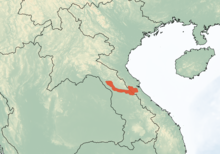| Laotian rock rat Temporal range: Late Miocene-Recent
| |
|---|---|

| |
| Young male | |
| Scientific classification | |
| Domain: | Eukaryota |
| Kingdom: | Animalia |
| Phylum: | Chordata |
| Class: | Mammalia |
| Order: | Rodentia |
| Family: | Diatomyidae |
| Genus: | Laonastes Jenkins, Kilpatrick, Robinson & Timmins, 2005 |
| Species: | L. aenigmamus
|
| Binomial name | |
| Laonastes aenigmamus Jenkins, Kilpatrick, Robinson & Timmins, 2005
| |

| |
The Laotian rock rat or kha-nyou[2] (Laonastes aenigmamus, Lao: ຂະຍຸ), sometimes called the "rat-squirrel", is a species of rodent found in the Khammouan region of Laos. The species was first described in a 2005 article by Paulina Jenkins and coauthors, who considered the animal to be so distinct from all living rodents, they placed it in a new family, Laonastidae. It is in the monotypic genus Laonastes.

In 2006, the classification of the Laotian rock rat was disputed by Mary Dawson and coauthors. They suggested the rat belongs to the ancient fossil family Diatomyidae, which was thought to have been extinct for 11 million years,[3] since the late Miocene. It would thereby represent a Lazarus species. The animals resemble large, dark rats with hairy, thick tails like those of a squirrel. Their skulls are very distinctive and have features that separate them from all other living mammals.
- ^ Duckworth, J.W. (2016). "Laonastes aenigmamus". IUCN Red List of Threatened Species. 2016: e.T136474A22199035. doi:10.2305/IUCN.UK.2016-2.RLTS.T136474A22199035.en. Retrieved 11 November 2021.
- ^ Owen, James (May 16, 2005). "New Rodent Discovered at Asian Food Market". National Geographic News. Archived from the original on May 19, 2005. Retrieved Sep 19, 2010.
...odd-looking mammal, known locally as the kha-nyou....
- ^ Srikameswaran, Anita (June 15, 2006). "Retired professor tracks down rodent thought to be extinct". Pittsburgh Post-Gazette. Retrieved Sep 19, 2010.
Dr. Dawson and her colleagues... determined that the rock rats belonged to a family called Diatomyidae, whose members were thought to have died off more than 11 million years ago.
